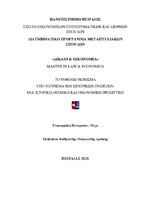Το ψηφιακό νόμισμα υπό το πρίσμα των Κεντρικών Τραπεζών: μια ιστορική, θεσμική και οικονομική προσέγγιση

Master Thesis
Συγγραφέας
Γλυκοφρύδη, Παναγιώτα Όλγα
Ημερομηνία
2021-03-24Επιβλέπων
Αρτίκης, ΠαναγιώτηςΠροβολή/
Λέξεις κλειδιά
Ψηφιακό νόμισμα ; Κεντρικές τράπεζεςΠερίληψη
Η ταχεία ανάπτυξη της τεχνολογίας έχει αναπτύξει σημαντικά το ηλεκτρονικό εμπόριο, το οποίο έχει πλέον καθιερωθεί ως μέσο διαπραγμάτευσης πρώτης γραμμής, κοινώς αποδεκτό από όλους. Αυτό που εξακολουθεί να μην είναι απολύτως αποδεκτό είναι οι πληρωμές στο επιγραμμικό εμπορικό περιβάλλον. Οι περιπτώσεις απάτης εξακολουθούν να είναι υψηλές, όπως και οι φόροι επί των συναλλαγών, έτσι και οι τεχνολογικές κοινότητες αναζητούν έναν νέο τρόπο συναλλαγών, άμεσο, πιο αξιόπιστο και χωρίς υψηλές χρεώσεις. Έτσι ξεκίνησε η δημιουργία ψηφιακών νομισμάτων που έφεραν μεγάλες ανακατατάξεις στις ηλεκτρονικές συναλλαγές. Χάρη σε αυτά τα νομίσματα, ο καθένας μπορεί να πραγματοποιήσει οποιαδήποτε συναλλαγή, χωρίς να χρειάζεται να κινηθεί, σε ένα ασφαλές και ανώνυμο περιβάλλον και, το πιο σημαντικό, χωρίς τη μεσολάβηση τρίτων, δεδομένου ότι κανείς άλλος δεν παρεμβαίνει στη συναλλαγή.
Σε αντίθεση με τη χρήση πραγματικών χρημάτων από χρηματοπιστωτικά ιδρύματα, τα οποία επηρεάζουν αρνητικά το κόστος μιας συναλλαγής, η ασφάλεια της χρήσης των κρυπτονομισμάτων οφείλεται σε ένα εξελιγμένο ηλεκτρονικό σύστημα συναλλαγών που ονομάζεται blockchain, το οποίο εμποδίζει οποιαδήποτε κακόβουλη ενέργεια που προσπαθεί να τα υποκλέψει. Αυτό μειώνει επίσης τη δυσπιστία μεταξύ των προσώπων που συναλλάσσονται και δεν απαιτούνται τόσες πολλές διαπιστεύσεις, προκειμένου να προχωρήσει μια συναλλαγή. Ωστόσο, η έννοια του ψηφιακού νομίσματος δεν έχει ακόμη καθιερωθεί ως χρήμα όπως το γνωρίζουμε, αλλά θεωρείται περισσότερο ως επένδυση, καθώς με την πάροδο του χρόνου η αξία του αλλάζει πάρα πολύ.
Στην παρούσα διπλωματική θα αναλύσουμε το ψηφιακό νόμισμα, παρουσιάζοντας τα πλεονεκτήματα κατά τη χρήση του, τον τρόπο εφαρμογής του στις διαδικτυακές αγορές και τις μεθόδους απόκτησης του. Στην συνέχεια θα γίνει αναφορά στην νομική και οικονομική προσέγγιση του ψηφιακού νομίσματος. Επίσης θα μιλήσουμε για το πιο διάσημο ψηφιακό νόμισμα, το bitcoin και πώς κατάφερε σε σύντομο χρονικό διάστημα να ενισχύσει τη δημοτικότητά του, αλλά και τις μεγάλες και ξαφνικές αλλαγές στην αξία του. Η κατανόηση της σημασίας και της αξίας του θα συμβάλει στη σύντομη και ταυτόχρονα ολοκληρωμένη αναφορά στην έννοια και την ιστορία του χρήματος, από τη σύλληψη της ιδέας του, μέχρι τον σημερινό εκσυγχρονισμό του, καθώς και στο πόσο σημαντικό έπαιξε στο εμπόριο και την εξέλιξή του όλα αυτά τα χρόνια. Τέλος, θα συνοψίσουμε όλα τα παραπάνω, παρουσιάζοντας εν κατακλείδι τα οφέλη και τις συνέπειες που προκύπτουν από την εμφάνιση αυτής της εναλλακτικής μεθόδου πληρωμής και ποιες είναι οι τελευταίες εξελίξεις, οι οποίες μας δίνουν σημαντικές πληροφορίες σχετικά με τη νέα τάση των ηλεκτρονικών συναλλαγών και το ψηφιακό νόμισμα.


